
Recently on Cyclingnews.com |
L'Etape du Tour feature, Gap - L'Alpe d'Huez, part 2
A failing sense of confidence
Part 1 is here
Mark Sharon was one of the 8500 riders who started l'Etape 2006. At this point of l'Etape he has reached the halfway point but the major climbs of the day await, the Col du Lartaret and the 21 numbered corners of the imposing l'Alpe d'Huez. As Sharon would find out, riding the stage is only one of the difficulties...
"Briançon is doing a fair impersonation of Darfur, or some other wretched aid distribution point. "-Sharon describes what it's like trying to get water at l'etape. |
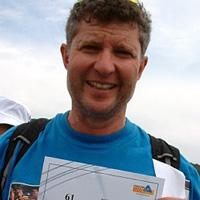
|
Briançon is doing a fair impersonation of Darfur, or some other wretched aid distribution point. There is an air of, if not panic, then certainly of mounting desperation. Water is in short supply and riders are raiding the backs of the supply trucks themselves. I foresee a point when the back-markers are drinking from the muddy puddles. I snaffle a six-pack of mineral water, top up the water bottles and make my escape.The first section out of Briançon is a knee-locking 11 percent, but then we are in for a long haul. The Col du Lautaret is 30 km away at an average of 4.4 percent - possibly the most tedious climb in Etape du Tour history. However, it is more than made up for by the scenery, which is magnificent, with the peak of La Meije and its glaciers dominating the skyline.
The Col du Lautaret is a welcome sight, and busy. Those not in cafés are stocking up from the fountain - make that a tap over a horse trough. The water is cold, and you can forgive it the milky colour - I am sure it is just bubbles and minerals.Now for the final descent - 38km to Bourg D'Oisans. Normally, I would be concerned not to catch a chill - not this day. I have kept my gilet on, but the air is hot and it is like riding in the face of a hairdryer.
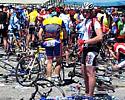
|
The descent has two hazards. First is the road surface which is a patch-work quilt of repairs scarred by cracks. The second is the tunnels, which are narrow poorly lit tubes cut through the rock. The challenge is to whip up your sunglasses just in time while trying not be thrown off your bike by the road surface. But at least the tunnels are a cool, albeit brief, respite from the heat.
We pass across the dam at the foot of Lac du Chambon, which of us didn't comtemplate a quick dip? Then on to the final section of descent and more tunnels. At the turn-off to the mountain-climbing centre of La Berade the road straightens out and we are on the approach road to the foot of l'Alpe d'Huez. I will confess at this point to a failing sense of confidence. I am suffering, tired and uncomfortable on the bike. The road is dead straight and is dotted with small clumps of riders all with the same thing in mind - ease up and chat. The penultimate challenge is to get past the elimination point at the foot of L'Alpe d'Huez and my group is a clear 45 minutes inside the cut-off time.

|
A massive crowd has gathered at the turn into the feed-stop, but I am so tired I hardly raise my eyes to scan the crowd for mates. At the feed-stop I grab an energy bar and down a bottle of water. Then I make the mistake of taking a swig of energy gel. It has been sitting in my back pocket all day and it is hot. Suddenly, my stomach cramps and the entire contents of my stomach, which is almost solely water, reappears - "oops that's not good" I think.
Nevertheless, I force myself back on the bike, go cross the timing mat and hit the first of the ramps. At precisely the same time the 'man with the hammer' taps me on the head. By the time I reach the top of the second ramp I am in serious trouble. I am simply out of gas. After walking for perhaps half a kilometre I take a break on the crash barrier before climbing back on. In another kilometre I stop again - this time for good. First I sit on the wall, then I am leaning against it. Finally I end up flat on my back on the road.
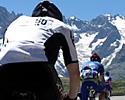
|
I let the first of the ambulances go by, then the second, but the third pulls up and I find myself surrounded by paramedics - some of them look like teenagers - I must be getting old. I am 7 km from the summit, but I might as well be back in Gap. One of the paramedics asks me what's wrong and clamps a monitor around my wrist. I tell her I am "vide" - empty. She nods and orders the ambulance backed up so I can be loaded on board.
I make a quick call to my wife waiting at the finish with my boys to tell her the outcome. I can tell she is both concerned and relieved. Apparently the ambulances have been doing a roaring trade all afternoon. There is a further ignominy before we set off up the hill when one of the officials stops and takes off my timing chip, but I am too far gone to bother.
Soon I hear the cheers of the crowd waiting and we cross the finish line - not as I set out to do that morning, but nevertheless I am glad for it to be over. The ambulance doors are thrown open and I see the anxious faces of my wife and boys. There is Maurice too, not sure how I will react to his excellent time up the hill. I am overjoyed for him the silly sod and of course a little jealous of his finishers medal. I am escorted to the medical tent next to the finish line, which is like a scene out of MASH. It is literally so full that casualties are being lined up outside on stretchers - no one is dead of course, but there is every conceivable case ranging from broken arms to heat stroke. I don't feel alone at least.
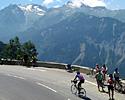
|
According to the race organisation, of the 7,548 who started the race in Gap by 18.00, the official close of the race, 5,477 riders had finished. This was the official statistic. Apparently riders were still turning up late into the night. I was grateful to have got as far as I did.
After the race I was talking to a couple of Brits, Pete Gregory and Peter Thornton. One of their friends had arguably the worst day that didn't involve injury. He started right at the back of the field and with the crowd got a slow start, so slow that he was swept up by the Broom-wagon after just 7 km and spent 11 hours in the bus following the race. I think this could be a case for the organisation to base elimination by the broom-wagon on race number. I don't see why those at the front should get a 30 minute buffer.
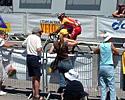
|
But what was climbing L'Alpe du Huez like? John Reed, who did the race in 2005 and finished this year in 09h 42' 53" describes it thus: "The distance of last year's event effectively just got us to the bottom of L'Alpe d'Huez. By the time I got to Bourg d'Oisans I was utterly tired. In fact I had two full bottles at the bottom, but no matter what I couldn't get the energy to drink from them. I was relying solely on water from spectators. In actual fact it is pointless telling people who weren't there what it was like - it was so hot and hard, just indescribable."
Some had a much better time of it. Maurice Chabot, who set off with me from Gap that morning, finished in 09h 14' 36", and climbed L'Alpe d'Huez in 01h 33' 34", "When I arrived at the bottom of L'Alpe d'Huez, I was really scared of the first section. I took a big breath and started climbing. The first three kilometres were much harder than I expected. At every bend I drank some water because it was easier than on the bits in between. I was really tired by the tenth corner. Lot's of people were starting to put their feet down, but I was determined not to be one of them. I was always over-taking someone, which gave me a real morale boost. When I saw the 4 km to go sign I knew I could finish. According to my wife I was crying when I crossed the line - but I tell you it was for joy." Luc Humbert on the other hand climbed off on the Col du Lautaret, his 203cm frame succumbing to the heat.
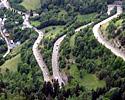
|
For the record the race was won by 21 year old Blaise Sonnery in 6h and 33 seconds. The fastest woman was Karine Saysset with a time of 6h 36' 42".
As for 2007, apart from knowing the race starts in London, UK, everyone will have to wait until October to discover where they'll get their next fix of Etape du Tour. I for one am hoping for something even tougher than this year - if that is possible.
Part 3 of this story - a short and colourful history of l'Etape, is here.
Credits:Cyclingnews would like to thank the following organisations for their help:
Travel: Brittany Ferries - www.brittanyferries.com
Accommodation: Lawrie Cranley at www.bikestyletours.com
Frame: Giant Bicycle Company - www.giantbicycles.com
Saddle/Seatpost: Specialized UK - www.specialized.com
Handlebars/Stem: ITM - www.itm.it / www.jimwalker.co.uk
Groupset/Wheels: Campagnolo - www.campagnolo.com
Tyres and clothing: Continental - www.conti-tyres.co.uk
Photography
For a thumbnail gallery of these images, click here
Images by Mark Sharon and friends
- Road notice.
- Start village entrance arch.
- Author with dossard.
- Collecting race numbers.
- Checking names on the start list.
- Author and family checking names of friends.
- The lady who checks the timing.
- Information at the start village.
- Start village crowd around the information boards.
- Riders scrutinise the information boards.
- Crowd listening to the tombola being announced.
- Start village climbing wall.
- Local specialities at the start village.
- Queuing for the bike park.
- Bikes racked in the bike park.
- Mavic assistance at the start village.
- Start village sponsor stands.
- The Tour de France on the start village big screen.
- Entrance to the start village.
- Start village entertainers.
- Start village entertainer.
- Canadian patriotism.
- Start village sponsor stands.
- Start village bike park and Mavic assistance.
- Authors trusty steed.
- Outdoor privy before the start.
- Loo queue on race day.
- Riders await the start.
- Race day bike detail.
- View from the cockpit.
- Author awaits the start.
- Gathering for the depart.
- The peloton heads into the mountains.
- Heading into the morning sun on race day.
- The Lac de Serre Poncon'
- The sun also rises.
- 50km down 141 to go.
- Feedstop melee.
- Piles of oranges at the feedstop.
- 50km to the Col d'Izoard.
- Combes to Queyras.
- Combes to Queyras.
- Towards Col d'Izoard
- Peloton is strung out.
- Peloton tackles the Gorges.
- Author feels the heat.
- Mobbing a fountain.
- Brunissard at 80km.
- The peloton stretches back down the valley.
- Nearing the Col d'Izoard.
- On the Col d'Izoard.
- Entering the Casse Desserte.
- In the Casse Desserte.
- Approaching the summit of the Col d'Izoard.
- At the summit of the Col d'Izoard.
- One of the few women in the Peloton approaching the summit of the Col d'Izoard.
- The feed stop at Briancon resembles a war zone.
- The peloton heads towards the Col du Lautaret.
- Stocking up at a fountain on the Col du Lautaret.
- The never-ending trek up the Col du Lautaret
- Col du Lautaret just 2km to go.
- Near the Col du Lautaret with La Meije in the distance.
- At corner nine on Alpe d'Huez.
- Col du Lautaret riders jostle to fill water bottles.
- Alongside Lac du Chambon.
- The road across the Chambon dam.
- Riders cross the Barrage du Chambon.
- Foot of the Lac du Chambon.
- Descending the Col de Lautaret with 150km done.
- Descending the Col de Lautaret.
- Near Bourg d'Oisans.
- Last stretch near Bourg d'Oisans.
- Reaching the feed station at the foot of Alpe d'Huez.
- Alpe d'Huez first ramp.
- Corners on Alpe d'Huez.
- On Alpe d'Huez near corner 14.
- On Alpe d'Huez.
- Corner nine on Alpe d'Huez.
- Looking down on Huez en Oisans.
- Looking down Alpe d'Huez.
- Struggling up Alpe d'Huez.
- The corners of Alpe d'Huez.
- Alpe d'Huez jerseys for sale.
- The finishing straight.
- Riders in the finishing straight.
- Last 100 metres to the finish.
- Crowd at the finish.

